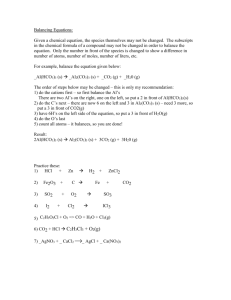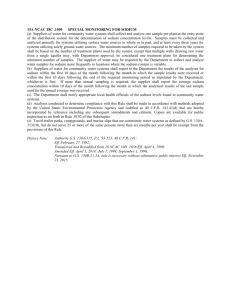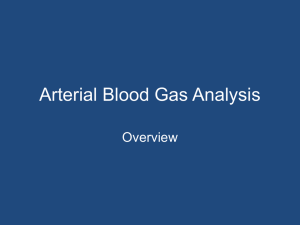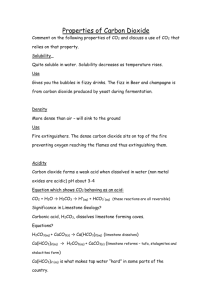The NCLEX-RN® Cram Sheet
advertisement
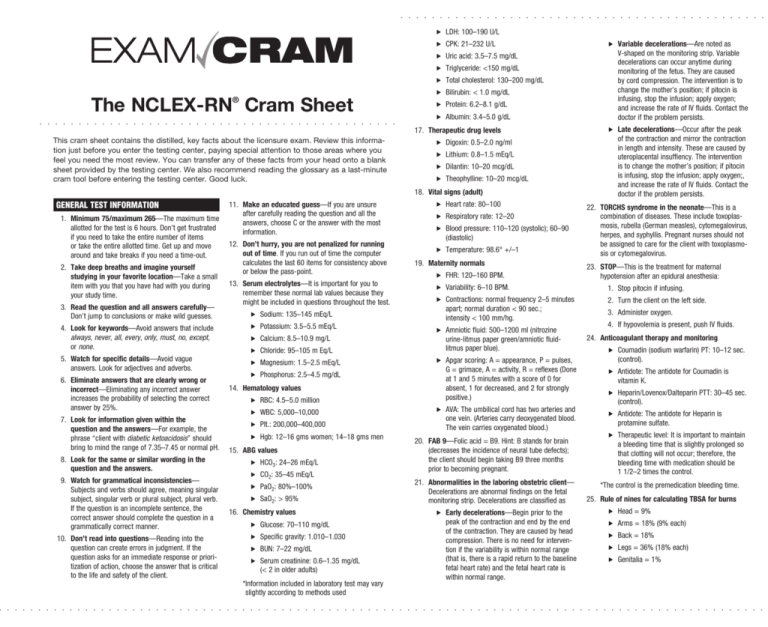
. . . . . . . . . . . . . . . . . . . . . . . . . . . . . . . . . . . . . . . . . . . . . . . The NCLEX-RN Cram Sheet ® . . . . . . . . . . . . . . . . . . . . . . . . . . . . . . . . . . . . . . . . . . . . . . This cram sheet contains the distilled, key facts about the licensure exam. Review this information just before you enter the testing center, paying special attention to those areas where you feel you need the most review. You can transfer any of these facts from your head onto a blank sheet provided by the testing center. We also recommend reading the glossary as a last-minute cram tool before entering the testing center. Good luck. . LDH: 100–190 U/L . CPK: 21–232 U/L . Uric acid: 3.5–7.5 mg/dL . Triglyceride: <150 mg/dL . Total cholesterol: 130–200 mg/dL . Bilirubin: < 1.0 mg/dL . Protein: 6.2–8.1 g/dL . Albumin: 3.4–5.0 g/dL 17. Therapeutic drug levels . Digoxin: 0.5–2.0 ng/ml . Lithium: 0.8–1.5 mEq/L . Dilantin: 10–20 mcg/dL . Theophylline: 10–20 mcg/dL . V ariable decelerations—Are noted as V-shaped on the monitoring strip. Variable decelerations can occur anytime during monitoring of the fetus. They are caused by cord compression. The intervention is to change the mother’s position; if pitocin is infusing, stop the infusion; apply oxygen; and increase the rate of IV fluids. Contact the doctor if the problem persists. . L ate decelerations—Occur after the peak of the contraction and mirror the contraction in length and intensity. These are caused by uteroplacental insuffiency. The intervention is to change the mother’s position; if pitocin is infusing, stop the infusion; apply oxygen;, and increase the rate of IV fluids. Contact the doctor if the problem persists. 18. Vital signs (adult) General Test Information 1. 2. 3. 4. 11. Make an educated guess—If you are unsure after carefully reading the question and all the Minimum 75/maximum 265—The maximum time answers, choose C or the answer with the most allotted for the test is 6 hours. Don’t get frustrated information. if you need to take the entire number of items 12. Don’t hurry, you are not penalized for running or take the entire allotted time. Get up and move out of time. If you run out of time the computer around and take breaks if you need a time-out. calculates the last 60 items for consistency above Take deep breaths and imagine yourself or below the pass-point. studying in your favorite location—Take a small 13. Serum electrolytes—It is important for you to item with you that you have had with you during remember these normal lab values because they your study time. might be included in questions throughout the test. Read the question and all answers carefully— . Sodium: 135–145 mEq/L Don’t jump to conclusions or make wild guesses. Look for keywords—Avoid answers that include . Potassium: 3.5–5.5 mEq/L always, never, all, every, only, must, no, except, . Calcium: 8.5–10.9 mg/L or none. . Chloride: 95–105 m Eq/L 5. Watch for specific details—Avoid vague answers. Look for adjectives and adverbs. 6. Eliminate answers that are clearly wrong or incorrect—Eliminating any incorrect answer increases the probability of selecting the correct answer by 25%. . Magnesium: 1.5–2.5 mEq/L . Phosphorus: 2.5–4.5 mg/dL . Heart rate: 80–100 . Respiratory rate: 12–20 . B lood pressure: 110–120 (systolic); 60–90 (diastolic) . Temperature: 98.6° +/–1 19. Maternity normals . FHR: 120–160 BPM. 23. STOP—This is the treatment for maternal hypotension after an epidural anesthesia: . Variability: 6–10 BPM. 1. Stop pitocin if infusing. . C ontractions: normal frequency 2–5 minutes apart; normal duration < 90 sec.; intensity < 100 mm/hg. 2. Turn the client on the left side. 3. Administer oxygen. 4. If hypovolemia is present, push IV fluids. 14. Hematology values . RBC: 4.5–5.0 million 7. Look for information given within the question and the answers—For example, the phrase “client with diabetic ketoacidosis” should bring to mind the range of 7.35–7.45 or normal pH. 15. 8. Look for the same or similar wording in the question and the answers. 9. Watch for grammatical inconsistencies— Subjects and verbs should agree, meaning singular subject, singular verb or plural subject, plural verb. If the question is an incomplete sentence, the 16. correct answer should complete the question in a grammatically correct manner. 10. Don’t read into questions—Reading into the question can create errors in judgment. If the question asks for an immediate response or priori- tization of action, choose the answer that is critical to the life and safety of the client. . WBC: 5,000–10,000 . Plt.: 200,000–400,000 . Hgb: 12–16 gms women; 14–18 gms men ABG values . HCO3: 24–26 mEq/L . CO2: 35–45 mEq/L 22. TORCHS syndrome in the neonate—This is a combination of diseases. These include toxoplasmosis, rubella (German measles), cytomegalovirus, herpes, and syphyllis. Pregnant nurses should not be assigned to care for the client with toxoplasmosis or cytomegalovirus. . A mniotic fluid: 500–1200 ml (nitrozine urine-litmus paper green/amniotic fluidlitmus paper blue). 24. Anticoagulant therapy and monitoring . A pgar scoring: A = appearance, P = pulses, G = grimace, A = activity, R = reflexes (Done at 1 and 5 minutes with a score of 0 for absent, 1 for decreased, and 2 for strongly positive.) . A VA: The umbilical cord has two arteries and one vein. (Arteries carry deoxygenated blood. The vein carries oxygenated blood.) 20. FAB 9—Folic acid = B9. Hint: B stands for brain (decreases the incidence of neural tube defects); the client should begin taking B9 three months prior to becoming pregnant. . C oumadin (sodium warfarin) PT: 10–12 sec. (control). . A ntidote: The antidote for Coumadin is vitamin K. . H eparin/Lovenox/Dalteparin PTT: 30–45 sec. (control). . A ntidote: The antidote for Heparin is protamine sulfate. . T herapeutic level: It is important to maintain a bleeding time that is slightly prolonged so that clotting will not occur; therefore, the bleeding time with medication should be 1 1/2–2 times the control. . SaO2: > 95% 21. Abnormalities in the laboring obstetric client— Decelerations are abnormal findings on the fetal monitoring strip. Decelerations are classified as Chemistry values . E arly decelerations—Begin prior to the peak of the contraction and end by the end of the contraction. They are caused by head compression. There is no need for intervention if the variability is within normal range (that is, there is a rapid return to the baseline fetal heart rate) and the fetal heart rate is within normal range. . Head = 9% . Arms = 18% (9% each) . Back = 18% . PaO2: 80%–100% . Glucose: 70–110 mg/dL . Specific gravity: 1.010–1.030 . BUN: 7–22 mg/dL . S erum creatinine: 0.6–1.35 mg/dL (< 2 in older adults) *Information included in laboratory test may vary slightly according to methods used *The control is the premedication bleeding time. 25. Rule of nines for calculating TBSA for burns . Legs = 36% (18% each) . Genitalia = 1% . . . . . . . . . . . . . . . . . . . . . . . . . . . . . . . . . . . . . . . . . . . . . . . . . . . . . . . . . . . . . . . . . . . . . . . . . . . . . . . . . . . . . . . . . . . . . . . . . . . . . . . . . . . . . . . . . . . . . . . . . . . . . . . . . . . . . . . . . . . . . . . . . . . . . . . . . . . . . . . . . . . . . . . . . . . . . . . . . . . . . . . . . . . . . . . . . . . . Cultural and Religious Considerations in Health Care . pH up, CO2 down, and HCO3 down = 26. Arab American cultural attributes—Females respiratory alkalosis avoid eye contact with males; touch is accepted . pH up, CO2 up, and HCO3 up = metabolic if done by same-sex healthcare providers; most alkalosis decisions are made by males; Muslims (Sunni), refuse organ donation; most Arabs do not eat pork; 33. Addison’s versus Cushing’s—Addison’s and they avoid icy drinks when sick or hot/cold drinks Cushing’s are diseases of the endocrine system together; colostrum is considered harmful to the involving either overproduction or inadequate newborn. production of cortisol: 27. Asian American cultural attributes—They avoid . Treatment for the client with Addison’s: direct eye contact; feet are considered dirty (the feet increase sodium intake; medications include should be touched last during assessment); males cortisone preparations. make most of the decisions; they usually refuse . Treatment for the client with Cushing’s: organ donation; they generally do not prefer cold restrict sodium; observe for signs of infection. drinks, believe in the “hot-cold” theory of illness. 34. Treatment for spider bites/bleeding—RICE (rest, 28. Native American cultural attributes—They ice, compression, and elevate extremity) sustain eye contact; blood and organ donation is generally refused; they might refuse circumcision; 35. may prefer care from the tribal shaman rather than using western medicine. 36. 29. Mexican American cultural attributes—They might avoid direct eye contact with authorities; they might refuse organ donation; most are very emotional during bereavement; believe in the “hot-cold” theory of illness. 30. Religions beliefs . Jehovah’s Witness—No blood products should be used . Hindu—No beef or items containing gelatin . J ewish—Special dietary restrictions, use of kosher foods Treatment for sickle cell crises—HHOP (heat, hydration, oxygen, pain medications) . Pain . Pallor 38. Profile of gallbladder disease—Fair, fat, forty, five pregnancies, flatulent (actually gallbladder . Renal diet—High calorie, high carbohydrate, disease can occur in all ages and both sexes). low protein, low potassium, low sodium, and fluid restricted to intake = output + 500 ml Tips for Assigning Staff Duties . G out diet—Low purine; omit poultry (“cold chicken”) medication for acute episodes: 39. Management and delegation Colchicine; maintenance medication: Zyloprim . Delegate sterile skills such as dressing chang . Heart healthy diet—Low fat (less than es to the RN or LPN. Where nonskilled care is 30% of calories should be from fat) required, you can delegate the stable client to the nursing assistant. Choose the most critical 32. Acid/base balance client to assign to the RN, such as the client . ROME (respiratory opposite/metabolic equal) who has recently returned from chest surgery. is a quick way of remembering that in respiClients who are being discharged should have ratory acid/base disorders the pH is opposite final assessments done by the RN. to the other components. For example, in . The PN, like the RN, can monitor clients with respiratory acidosis, the pH is below normal IV therapy, insert urinary catheters and feedand the CO2 is elevated, as is the HCO3 ing tubes, apply restraints, discontinue IVs, (respiratory opposite). In metabolic disorders, drains, and sutures. the components of the lab values are the . For room assignments, do not coassign the same. An example of this is metabolic acipost-operative client with clients who have dosis. In metabolic acidosis, the pH is below vomiting, diarrhea, open wounds, or chest normal and the CO2 is decreased, as is the tube drainage. Remember the A, B, Cs (airHCO3. This is true in a compensated situation. way, breathing, circulation) when answering . pH down, CO2 up, and HCO3 up = respiratory questions choices that ask who would you acidosis see first. For hospital triage, care for the . H istamine 2 antagonist drugs: Cimetidine (Tagamet), famotidine (Pepcid), nizatidine (Axid), rantidine (Zantac) . P roton pump inhibitors: Esomeprazole (Nexium), lansoprazole (Prevacid), pantoprazole (Protonix), rabeprazole (AciPhex) 40. Examples of types of drugs . A nticoagulant drugs: Heparin sodium (Hepalean), enoxaparin sodium (Lovenox), dalteparin sodium (Fragmin) *The generic name is listed first with the trade name in parentheses. 41. Drug schedules . A ngiotensin-converting agents: Benazepril (Lotensin), lisinopril (Zestril), captopril (Capoten), enalapril (Vasotec), fosinopril (Monopril), moexipril (Univas), quinapril (Acupril), ramipril (Altace) . S chedule I—Research use only (example LSD) . S chedule II—Requires a written prescription (example Ritalin) . S chedule III—Requires a new prescription after six months or five refills (example codeine) . S chedule IV—Requires a new prescription after six months (example Darvon) . S chedule V—Dispensed as any other prescription or without prescription if state law allows (example antitussives) . Paresthesia 37. Hip fractures—Hip fractures commonly hemorrhage, whereas femur fractures are at risk for fat emboli. . A ngiotensin receptor blocker drugs: Valsartan (Diovan), candesartan (Altacand), losartan (Cozaar), telmisartan (Micardis) Legalities—The RN and the physician institute seclusion protection. . Pulselessness . Polar (cold) Legal Issues in Nursing Review common legal terms: tort, negligence, malpractice, slander, assault, battery. Five Ps of fractures and compartment syndrome—These are symptoms of fractures and compartment syndrome: 31. Therapeutic diets client with a life-threatening illness or injury first. For disaster triage, choose to triage first those clients who can be saved with the least use of resources. . p H down, CO2 down, and HCO3 down = metabolic acidosis . B eta adrenergic blockers: Acebutolol (Monitan, Rhotral, Sectral), atenolol (Tenormin, Apo-Atenol, Nova-Atenol), esmolol (Brevibloc), metaprolol (Alupent, Metaproterenol), propanolol (Inderal) . A nti-infective drugs: Gentamicin (Garamycin, Alcomicin, Genoptic), kanamycin (Kantrex), neomycin (Mycifradin), streptomycin (Streptomycin), tobramycin (Tobrex, Nebcin), amikacin (Amikin) . B enzodiazepine drugs: Clonazepam (Klonopin), diazepam (Valium), chlordiazepoxide (Librium), lorazepam (Ativan), flurazepam (Dalmane) . P henothiazine drugs: Chlopromazine (Thorazine), prochlorperazine (Compazine), trifluoperazine (Stelazine), promethazine (Phenergan), hydroxyzine (Vistaril), fluphenazine (Prolixin) . G lucocorticoid drugs: Prednisolone (DeltaCortef, Prednisol, Prednisolone), prednisone (Apo-Prednisone, Deltasone, Meticorten, Orasone, Panasol-S), betamethasone (Celestone, Selestoject, Betnesol), dexamethasone (Decadron, Deronil, Dexon, Mymethasone, Dalalone), cortisone (Cortone), hydrocortisone (Cortef, Hydrocortone Phosphate, Cortifoam), methylprednisolone (Solu-cortef, Depo-Medrol, Depopred, Medrol, Rep-Pred), triamcinolone (Amcort, Aristocort, Atolone, Kenalog, Triamolone) 42. Medication classifications commonly used in a medical/surgical setting . A ntacids—Reduce hydrochloric acid in the stomach . A ntianemics—Increase red blood cell production . Anticholenergics—Decrease oral secretions . Anticoagulants—Prevent clot formation . A nticonvulsants—Used for management of seizures/bipolar disorder . A ntidiarrheals—Decrease gastric motility and reduce water in bowel . A ntihistamines—Block the release of histamine . A ntihypertensives—Lower blood pressure and increase blood flow . A nti-infectives—Used for the treatment of infections . B ronchodilators—Dilate large air passages in asthma/lung disease . D iuretics—Decrease water/sodium from the Loop of Henle . A ntivirals: Acyclovir (Zovirax), ritonavir (Norvir), saquinavir (Invirase, Fortovase), indinavir (Crixivan), abacavir (Ziagen), cidofo- vir (Vistide), ganciclovir (Cytovene, Vitrasert) . Cholesterol-lowering drugs: Atorvastatin (Lipitor), fluvastatin (Lescol), lovastatin (Mevacor), pravastatin (Pravachol), simvastatin (Zocar), rosuvastatin (Crestor) . Laxatives—Promote the passage of stool . Miotics—Constrict the pupils . Mydriatics—Dilate the pupils . N arcotics/analgesics—Relieve moderate to severe pain . . . . . . . . . . . . . . . . . . . . . . . . . . . . . . . . . . . . . . . . . . . . . . . . . . . . . . . . . . . . . . . . . . . . . . . . . . . . . . . . . . . . . . . . . . . . . . . . . .
